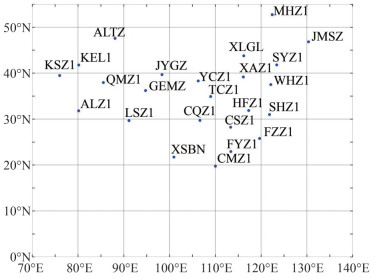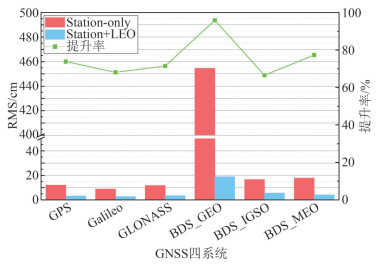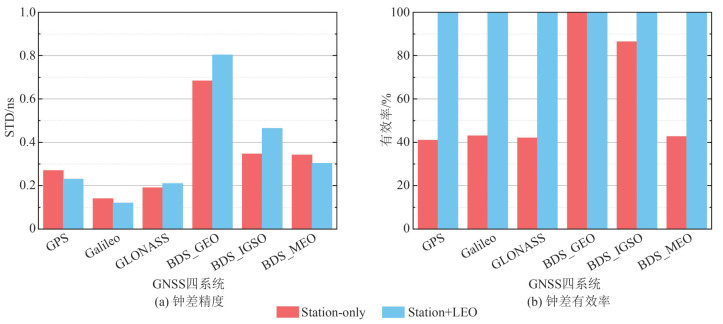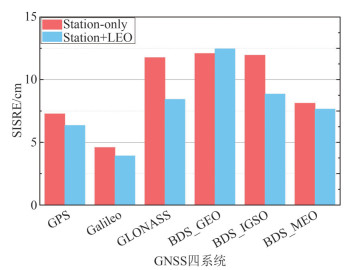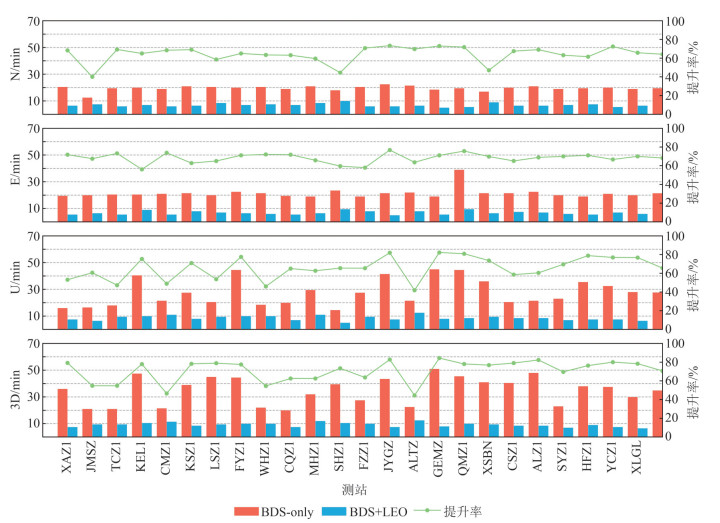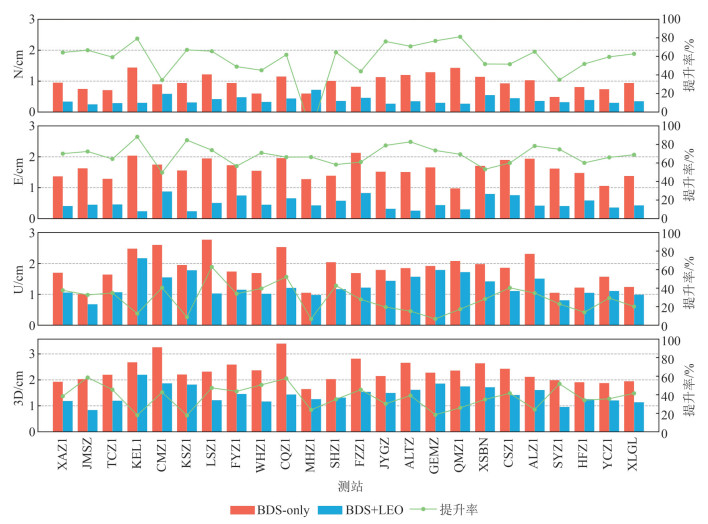Simulation and Comprehensive Performance Evaluation of the Integrated Space-Ground System for Low Earth Orbit-Enhanced BeiDou Navigation Satellite System
-
摘要:
北斗卫星导航系统将考虑纳入低轨星座,通过高中低轨星座融合,构建全球覆盖时空网络。然而,低轨星座正处于建设阶段,对低轨增强北斗系统的研究尚缺少仿真和多方位的性能评估。围绕低轨增强北斗系统高逼真仿真和增强性能多方位评估开展研究,构建了融合实际测量数据和空间物理理论模型的高逼真低轨星座仿真模型,提出了低轨增强系统综合性能评估方法,设计建立了低轨增强北斗的星地一体化系统仿真及综合性能评估平台,揭示了低轨星座对已有导航系统性能增强效果。结果显示,在系统侧方面,低轨增强在提升北斗精密产品精度的同时可减少地面测站数量及分布限制;在用户侧方面,低轨卫星的加入有望使北斗精密单点定位收敛时间缩短至10 min以内。研究成果可为低轨增强导航系统建设提供理论和应用支撑。
Abstract:ObjectivesThe integration of low earth orbit (LEO) constellations into the BeiDou satellite navigation system has been under consideration, aiming to establish a global coverage space-time network through the fusion of high, medium, and low earth orbit constellations. However, it should be noted that the LEO constellation is currently in the construction phase, and there is a lack of comprehensive simulation and performance evaluation for the LEO-enhanced BeiDou system.
MethodsTherefore, In this contribution, research is conducted centered around the highly realistic simulation and comprehensive performance evaluation of the LEO-enhanced BeiDou system, a sophisticated simulation model of the LEO constellation was developed by integrating actual measurement data and space physics theoretical models, and then a comprehensive performance evaluation method for the LEO-enhanced system was proposed, and an integrated space-ground platform for simulation and comprehensive performance evaluation of the LEO-enhanced BeiDou system was designed and established, the research findings revealed the performance enhancement effects of the LEO constellation on the existing navigation system.
ResultsThe results indicate that, on the system-terminal, the LEO augmentation improves the precision of BeiDou's high-precision products while simultaneously reducing the limit on the number and distribution of ground stations. On the user-terminal, the inclusion of LEO satellites holds the potential to reduce the convergence time of BeiDou precise point positioning to less than 10 minutes.
ConclusionsThe research results provide theoretical and practical support for the development of the LEO-enhanced navigation system.
-
-
表 1 仿真LEO轨道的动力学模型信息
Table 1 Dynamical Model for Simulating LEO Orbit
动力学模型 模型信息 地球重力 EGM(120×120) N体引力 JPL DE405 固体潮和极潮 IERS 2010 海洋潮汐 FES 2004 相对论 IERS 2010 太阳光压 Box-Wing模型 大气阻力 DTM94 经验力参数 在轨道切向(A)、法向(C)及径向(R),每转一圈添加一个常数周期性加速度参数(sin和cos) 表 2 数据仿真策略
Table 2 Simulation Strategy of Observation
类型 仿真模型描述 观测数据 伪距和载波观测值:GPS:L1、L2;BDS2及BDS3:B1I、B3I;GLONASS:G1、G2;Galileo:E1、E5a 数据采样率/s 30 模糊度参数 随机生成整数0~100;星地GNSS数据:24 h弧段单频模糊度总数设置为10个,两个频点周跳历元位置随机产生;
星载GNSS及星地LEO数据:24 h弧段单频模糊度总数设置为50个,两个频点周跳历元位置随机产生PCO/PCV GNSS卫星采用igs14.atx,地面站和低轨卫星不考虑 对流层延迟 星地GNSS/LEO干延迟采用SAAF+GMF计算,不考虑湿延迟;星载GNSS不考虑两者 电离层延迟 星地GNSS:IGS电离层格网文件插值获得;星载GNSS及星地LEO:认为电离层的带电粒子在不同高度处均匀分布,基于IGS电离层格网文件插值获得覆盖整个电离层的投影路径电离层延迟,然后基于传播高度占总电离层高度比例获得最终电离层延迟 相位缠绕 模型计算 固体潮 IERS Conventions 2003 相对论效应 模型计算 测量噪声 星地GNSS:伪距为1.5 m,载波为4 mm;星载GNSS/星地LEO:伪距为2 m,载波为8 mm 表 3 数据处理策略和相关模型描述
Table 3 Description of Data Processing Strategies and Related Models
类型 数据处理和模型描述 观测弧段长度 区域监测网:72 h;区域监测网+LEO:24 h 观测数据 无电离层组合观测值:GPS:L1/L2;BDS2及BDS3:B1I/B3I;GLONASS:G1/G2;Galileo:E1/E5a 太阳光压模型 GPS/GLONASS/BDS2/BDS3 IGSO: 5参数ECOM1模型;BDS3 MEO:添加先验加速度的ECOM1模型[33];
Galileo:添加先验加速度的ECOM1模型[34];LEO: Box-Wing模型大气阻力 GNSS:无;LEO: DTM 94模型,每360 min添加一个常量尺度参数 经验力模型 GNSS:无;LEO: 每一个轨道周期在切向、法向及径向估计一组周期性常数经验力(sin和cos项)[35] 重力场模型 GNSS:EGM 12×12;LEO:EGM 150×150 观测值权 高度角(E)定权, E > 30°,权为1,否则为2sinE;截止高度角7° 数据采样率/s 300 系统间偏差 常数估计 模糊度参数 星地GNSS数据双差模糊度约束法方程,星载GNSS浮点解模式 卫星PCO/PCV GNSS卫星采用igs14.atx,地面站和低轨卫星不考虑 对流层延迟 地面站干延迟采用SAAF+GMF计算,不考虑天顶湿延迟,而LEO卫星不考虑两者 N体引力 JPL DE405 固体潮 IERS Conventions 2003 相对论效应 IERS Conventions 2003 表 4 跟踪GNSS弧段完整性/%
Table 4 GNSS Arc Integrity Tracking/%
卫星系统 Station-only Station+LEO GPS 80 100 GLONASS 78 100 Galileo 79 100 BDS_GEO 100 100 BDS_IGSO 100 100 BDS_MEO 83 100 表 5 GNSS四系统轨道解算精度及提升率
Table 5 Orbit Determination Precision and Improvement Rates for GNSS Four-System
卫星系统 解算精度/cm 提升率/% Station-only Station+LEO GPS 12.1 3.2 74 Galileo 8.8 2.8 68 GLONASS 11.8 3.4 71 BDS GEO 454.5 18.9 96 BDS IGSO 16.5 5.5 67 BDS MEO 17.7 4.0 77 表 6 PPP解算策略
Table 6 Processing Strategy for Precise Point Positioning
类型 数据处理和模型描述 定位模式 静态双频PPP 观测数据 BDS2/BDS3、LEO:B1I/B3I 电离层 BDS和LEO均采用无电离层组合 对流层 均采用SAAF+GMF进行参数估计 采样间隔/s 30 截止高度角/(°) 7 卫星天线相位中心偏差 GNSS采用igs14.atx,LEO不考虑 接收机天线相位中心偏差 不考虑 天线相位缠绕 模型改正 精密星历和钟差 仿真轨道钟差产品 参数估计 卡尔曼滤波 表 7 24个测站PPP平均收敛时间及提升率统计表
Table 7 PPP Convergence Time and Improvement Rate for 24 Stations
方向 平均收敛时间/min 提升率/% BDS-only BDS+LEO N 19.6 6.9 64 E 21.5 6.8 68 U 27.7 8.6 66 3D 34.9 9.2 71 表 8 24个测站PPP平均RMS及提升率统计表
Table 8 PPP Average RMS and Improvement Rate for 24 Stations
方向 平均RMS/cm 提升率/% BDS-only BDS+LEO N 0.97 0.38 57 E 1.60 0.50 69 U 1.82 1.27 28 3D 2.33 1.44 38 -
[1] 王密, 仵倩玉, 肖晶, 等. 低轨巨型星座遥感信息"云-边-端"智能服务关键技术[J]. 武汉大学学报(信息科学版), 2023, 48(8): 1256-1263. doi: 10.13203/j.whugis20220767 Wang Mi, Wu Qianyu, Xiao Jing, et al. Key Technologies on "Cloud-Edge-End" Collaborative Intelligent Service of Low-Orbit Giant Constellation[J]. Geomatics and Information Science of Wuhan University, 2023, 48(8): 1256-1263. doi: 10.13203/j.whugis20220767
[2] Keller H, Salzwedel H. Link Strategy for the Mobile Satellite System Iridium[C]//IEEE Vehicular Technology Conference, Atlanta, USA, 2002.
[3] Reid T G, Neish A M, Walter T F, et al. Leveraging Commercial Broadband LEO Constellations for Navigating[C]//The 29th International Technical Meeting of the Satellite Division of the Institute of Navigation, Portland, Oregon, USA, 2016.
[4] 张小红, 马福建. 低轨导航增强GNSS发展综述[J]. 测绘学报, 2019, 48(9): 1073-1087. https://www.cnki.com.cn/Article/CJFDTOTAL-CHXB201909002.htm Zhang Xiaohong, Ma Fujian. Review of the Development of LEO Navigation-Augmented GNSS[J]. Acta Geodaetica et Cartographica Sinica, 2019, 48(9): 1073-1087. https://www.cnki.com.cn/Article/CJFDTOTAL-CHXB201909002.htm
[5] "中国星网"成立![EB/OL]. [2023-08-28]. https://rfic.cuit.edu.cn/info/2095/1173.html. "China Star Network" Established![EB/OL]. [2023-08-28]. https://rfic.cuit.edu.cn/info/2095/1173.html.
[6] 《新时代的中国北斗》白皮书全文[EB/OL]. (2022-11-04) [2023-08-28]. http://www.beidou.gov.cn/zt/xwfbh/xsddzgbd/gdxw11/202211/t20221104_24806.html. "China BeiDou in the New Era" White Paper Full Text[EB/OL]. (2022-11-04) [2023-08-28]. http://www.beidou.gov.cn/zt/xwfbh/xsddzgbd/gdxw11/202211/t20221104_24806.html.
[7] Michalak G, Glaser S, Neumayer K H, et al. Precise Orbit and Earth Parameter Determination Supported by LEO Satellites, Inter-Satellite Links and Synchronized Clocks of a Future GNSS[J]. Advances in Space Research, 2021, 68(12): 4753-4782. doi: 10.1016/j.asr.2021.03.008
[8] 杨宇飞, 杨元喜, 徐君毅, 等. 低轨卫星对导航卫星星座轨道测定的增强作用[J]. 武汉大学学报(信息科学版), 2020, 45(1): 46-52. doi: 10.13203/j.whugis20180215 Yang Yufei, Yang Yuanxi, Xu Junyi, et al. Navigation Satellites Orbit Determination with the Enhancement of Low Earth Orbit Satellites[J]. Geomatics and Information Science of Wuhan University, 2020, 45(1): 46-52. doi: 10.13203/j.whugis20180215
[9] Joerger M, Gratton L, Pervan B, et al. Analysis of Iridium-Augmented GPS for Floating Carrier Phase Positioning[J]. Annual of Navigation, 2010, 57(2): 137-160. doi: 10.1002/j.2161-4296.2010.tb01773.x
[10] Li X, Ma F, Li X, et al. LEO Constellation-Augmented Multi-GNSS for Rapid PPP Convergence[J]. Journal of Geodesy, 2018, 93(5): 749-764.
[11] Enge P K, Ferrell B, Bennett J, et al. Orbital Diversity for Satellite Navigation[C]//The 25th International Technical Meeting of the Satellite Division of the Institute of Navigation (ION GNSS 2012), Nashville, TN, USA, 2012.
[12] Reid T G R, Neish A M, Walter T, et al. Broadband LEO Constellations for Navigation[J]. Navigation, 2018, 65(2): 205-220. doi: 10.1002/navi.234
[13] 赵智博, 任晓东, 张小红, 等. 联合GNSS/LEO卫星观测数据的区域电离层建模与精度评估[J]. 武汉大学学报(信息科学版), 2021, 46(2): 262-269. doi: 10.13203/j.whugis20190252 Zhao Zhibo, Ren Xiaodong, Zhang Xiaohong, et al. Regional Ionospheric Modeling and Accuracy Assessment Using GNSS/LEO Satellites Observations[J]. Geomatics and Information Science of Wuhan University, 2021, 46(2): 262-269. doi: 10.13203/j.whugis20190252
[14] Zhang T J, Shen H X, Li Z, et al. Restricted Constellation Design for Regional Navigation Augmentation[J]. Acta Astronautica, 2018, 150: 231-239. doi: 10.1016/j.actaastro.2018.04.044
[15] 田野, 张立新, 边朗. 低轨导航增强卫星星座设计[J]. 中国空间科学技术, 2019, 39(6): 55-61. https://www.cnki.com.cn/Article/CJFDTOTAL-ZGKJ201906008.htm Tian Ye, Zhang Lixin, Bian Lang. Design of LEO Satellites Augmented Constellation for Navigation[J]. Chinese Space Science and Technology, 2019, 39(6): 55-61. https://www.cnki.com.cn/Article/CJFDTOTAL-ZGKJ201906008.htm
[16] 聂欣, 郑晋军, 范本尧. 低轨卫星导航系统技术发展研究[J]. 航天器工程, 2022, 31(1): 116-124. https://www.cnki.com.cn/Article/CJFDTOTAL-HTGC202201016.htm Nie Xin, Zheng Jinjun, Fan Benyao. Study on Development of Technology Path for LEO Satellite Navigation System[J]. Spacecraft Engineering, 2022, 31(1): 116-124. https://www.cnki.com.cn/Article/CJFDTOTAL-HTGC202201016.htm
[17] Huang W, Männel B, Sakic P, et al. Integrated Processing of Ground- and Space-Based GPS Observations: Improving GPS Satellite Orbits Observed with Sparse Ground Networks[J]. Journal of Geodesy, 2020, 94(10). doi: 10.1007/s00190-020-01424-1
[18] Li X, Zhang K, Meng X, et al. LEO–BDS–GPS Integrated Precise Orbit Modeling Using FengYun-3D, FengYun-3C Onboard and Ground Observations[J]. GPS Solutions, 2020, 24(2).
[19] Li X, Zhang K, Ma F, et al. Integrated Precise Orbit Determination of Multi-GNSS and Large LEO Constellations[J]. Remote Sensing, 2019, 11(21).
[20] Li B, Ge H, Ge M, et al. LEO Enhanced Global Navigation Satellite System (LeGNSS) for Real-time Precise Positioning Services[J]. Advances in Space Research, 2019, 63(1): 73-93. https://www.sciencedirect.com/science/article/pii/S0273117718306264
[21] 曾添, 隋立芬, 贾小林, 等. 小型化LEO星座与BDS-3全星座联合定轨仿真[J]. 武汉大学学报(信息科学版), 2022, 47(1): 61-68. doi: 10.13203/j.whugis20190426 Zeng Tian, Sui Lifen, Jia Xiaolin, et al. Simulation of Combined Orbit Determination with a Small LEO Constellation and BDS-3 Full Constellation[J]. Geomatics and Information Science of Wuhan University, 2022, 47(1): 61-68. doi: 10.13203/j.whugis20190426
[22] 王磊, 陈锐志, 李德仁, 等. 珞珈一号低轨卫星导航增强系统信号质量评估[J]. 武汉大学学报(信息科学版), 2018, 43(12): 2191-2196. doi: 10.13203/j.whugis20180413 Wang Lei, Chen Ruizhi, Li Deren, et al. Quality Assessment of the LEO Navigation Augmentation Signals from Luojia-1A Satellite[J]. Geomatics and Information Science of Wuhan University, 2018, 43(12): 2191-2196. doi: 10.13203/j.whugis20180413
[23] Wu Z, Yu B, Sheng C, et al. In-flight Performance Analysis of the Navigation Augmentation Payload on LEO Communication Satellite: A Preliminary Study on WT01 Mission[J]. Geo-spatial Information Science, 2022, 25(1): 88-103.
[24] 贺延伟. 低轨星座设计及增强北斗三号分析[D]. 西安: 长安大学, 2022. He Yanwei. Design of LEO Constellation and Enhanced BDS-3 Analysis[D]. Xi'an: Chang'an University, 2022.
[25] Ge H, Li B, Ge M, et al. Initial Assessment of Precise Point Positioning with LEO Enhanced Global Navigation Satellite Systems (LeGNSS)[J]. Remote Sensing, 2018, 10(7): 984.
[26] Su M, Su X, Zhao Q, et al. BeiDou Augmented Navigation from Low Earth Orbit Satellites[J]. Sensors, 2019, 19(1): 198.
[27] Ma F, Zhang X, Hu J, et al. Frequency Design of LEO-Based Navigation Augmentation Signals for Dual-band Ionospheric-Free Ambiguity Resolution[J]. GPS Solutions, 2022, 26(2): 53. doi: 10.1007/s10291-022-01240-4
[28] 王乐, 折浩男, 王浩浩, 等. 北斗实时精密轨道和钟差产品解算策略及精度评定[J]. 导航定位与授时, 2020, 7(5): 37-44. https://www.cnki.com.cn/Article/CJFDTOTAL-DWSS202005007.htm Wang Le, She Haonan, Wang Haohao, et al. BDS Real-Time Precise Orbit and Clock Offset Products Solution Strategy and Accuracy Evaluation[J]. Navigation Positioning and Timing, 2020, 7(5): 37-44. https://www.cnki.com.cn/Article/CJFDTOTAL-DWSS202005007.htm
[29] 黄观文. GNSS星载原子钟质量评价及精密钟差算法研究[D]. 西安: 长安大学, 2012. Huang Guanwen. Research on Algorithms of Precise Clock Offset and Quality Evaluation of GNSS Satellite Clock[D]. Xi'an: Chang'an University, 2012.
[30] Chen L, Jiao W, Huang X, et al. Study on Signal-in-Space Errors Calculation Method and Statistical Characterization of BeiDou Navigation Satellite System[C]//China Satellite Navigation Conference, Shanghai, China, 2013.
[31] Heng L, Gao G, Walter T, et al. Statistical Characterization of GPS Signal-in-Space Errors [C]//International Technical Meeting of The Institute of Navigation, San Diego, CA, USA, 2012.
[32] Delgado N, Nunes F, Seco-Granados G. On the Relation Between GDOP and the Volume Described by the User-to-Satellite Unit Vectors for GNSS Positioning[J]. GPS Solutions, 2017, 21(3): 1139-1147. doi: 10.1007/s10291-016-0592-3
[33] Yan X, Liu C, Huang G, et al. A Priori Solar Radiation Pressure Model for BeiDou-3 MEO Satellites[J]. Remote Sensing, 2019, 11(13): 1605.
[34] Montenbruck O, Steigenberger P, Hugentobler U. Enhanced Solar Radiation Pressure Modeling for Galileo Satellites[J]. Journal of Geodesy, 2014, 89(3): 283-297.
[35] 赵齐乐, 刘经南, 葛茂荣, 等. 用PANDA对GPS和CHAMP卫星精密定轨[J]. 大地测量与地球动力学, 2005, 25(2): 113-116. https://www.cnki.com.cn/Article/CJFDTOTAL-DKXB200502020.htm Zhao Qile, Liu Jingnan, Ge Maorong, et al. Precise Orbit Determination of GPS and CHAMP Satellites with PANDA Software[J]. Crustal Deformation and Earthquake, 2005, 25(2): 113-116. https://www.cnki.com.cn/Article/CJFDTOTAL-DKXB200502020.htm





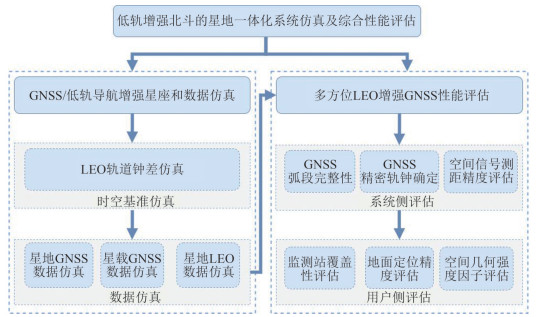
 下载:
下载:

